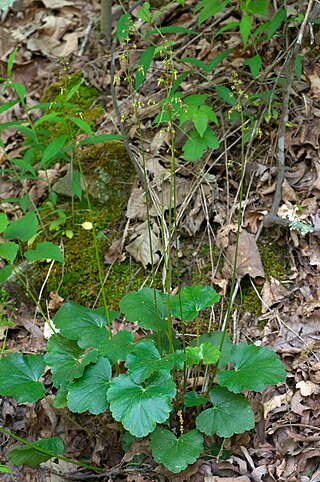Top Qs
Timeline
Chat
Perspective
Heuchera americana
Species of flowering plant From Wikipedia, the free encyclopedia
Remove ads
Heuchera americana, or American alumroot (also called Coral bells or Rock geranium), is a small (under 2 ft. high and wide) evergreen perennial native to eastern and central North America while also ranging into Ontario, Canada. It is a part of the Saxifrage family.
Remove ads
Characteristics

American alumroot has lobed semi-palmate green, purple, or brown leaves that may or may not be veined or marbled. Loose racemes of insignificant green to cream flowers up to 1 meter tall bloom June to August. It is a monecious plant with 5 stamen and can either have 5 petals and sepals or 5 tepals. The leaf arrangement is alternate. It is a ground cover plant. Found naturally in rock crevices and ledges of bluffs; it has a preference for acidic soil. It is susceptible to leaf scorch making it best grown in areas with at least some shade.[1][2][3][4][5]
This species has become popular with horticulturists and home-gardeners. It is usually grown for its unique foliage. New varieties are introduced regularly.[1]
Remove ads
Historical usage
American alumroot has been used by many Indigenous tribes in the past. For example, The Lumbee have used the herb to treat things like gastroenteritis, sore throats, ulcers, and dysentery while the Cherokee used American Alumroot to treat hemorrhoids, mouth soreness, irregular menstruation, and gastrointestinal problems.[6]
Current usage
The American alumroot has a lot of tannin which makes it very astringent and good for fixing dyes.
The American Alumroot has been proposed to help with cancer and vaginal discharges, but this connection has not been thoroughly researched. Its side effects are reported to be irritation of the stomach, and kidney and liver failure[7]
Gallery
- Heuchera americana 'Garnet' leaf
- Heuchera americana 'Garnet' emerging flower stalk
References
Further reading
Wikiwand - on
Seamless Wikipedia browsing. On steroids.
Remove ads



